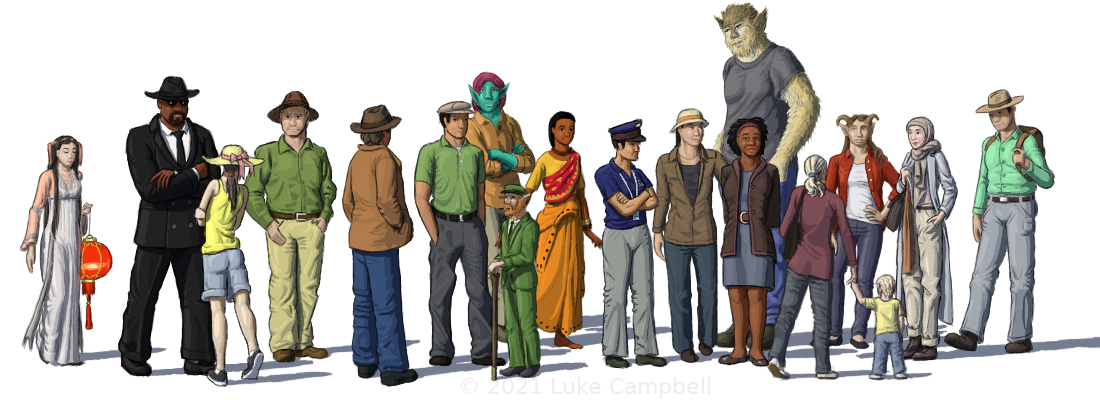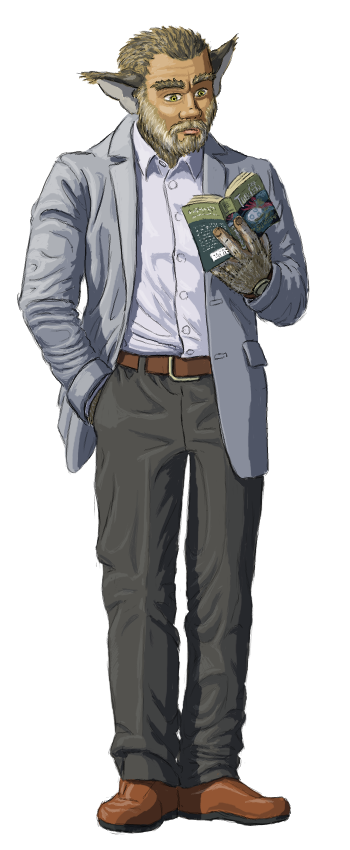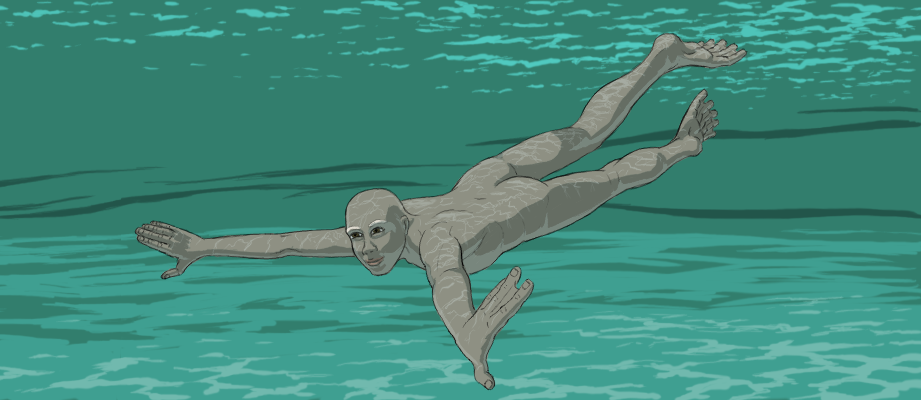| Humans | |||
|
DescriptionThe Humans of the Verge largely resemble the Humans of our modern Earth, although improved medical technology and a more active lifestyle mean that they are more fit on average and less likely to be overweight. The most significant portion claim descent from Americans, with their mix of dominantly European, Hispanic, and African heritage, and the next most significant ethnicity are descended from the Chinese. Many worlds were settled by refugees, so that depending on where you are you may find a significant proportion descended from Lithuanians, Arabs, Pacific Islanders, Bengalis, Columbia Plateau tribes, or other enthicities. A trend of cosmetic genetic engineering for a period on old Earth led to a minority of people in the Verge expressing unnatural traits such as oddly colored or patterned skin, pointed ears, body fur, exotic eyes, and the like. Thus, occasionally you might encounter a 2.5 meter tall man with thick gray skin, obsidian-black eyes, and ossicones on his forehead; or a petite woman with yellow-and-black striped fur over her body and pointed ears. These traits have generally reduced in number with each generation, but sometimes you will get recessive sports showing up from perfectly normal-looking parents. The most notable feature about humans to other sapient species is their height. Despite not having significantly more mass than other sapients, their upright posture lets them tower over the others. Even Pirang need to stretch to look a Human in the eye. Many non-Human sapients think Humans look unsteady teetering around on their two legs. Other sapients also tend to find it odd that Humans are almost always encountered wearing clothes, even in perfectly comfortable weather or indoors.
Common Variants
SensesHumans are visually dominant beings, capable of resolving and noticing fine details. Their vision picks up three primary colors – red, green, and blue – that are combined to produce a wide range of perceived colors that enable Humans to more easily pick out objects against a background. The natural height of a human gives them the ability to scan a wide area of ground when in open areas.Humans have a fairly dull sense of smell. While it still has some functionality, they are not nearly as good at sniffing out details as most other sapient species. Given that, the Human nose is unusually sensitive to fruity smells and detecting sulfurous compounds. CommunicationHumans' primary channel of communication is via speech. Since Humans shape their sounds by moving their mouth, their mouths open and close when they speak. Writing is used to communicate when immediate face-to-face communication is impractical. Facial expressions, posture, and tone of voice are also significant in direct person-to-person contact. Mouth shape, gaze direction, width of eye opening, and position of the Human's eyebrows all convey signals that other Humans instinctively understand but which might not be obvious to other species. English: Due to its history of settlement by the United States, the primary language of the Human-settled Verge worlds is English. It is the native language of the majority of the Human, Pannova, and Laer inhabitants, and the commonly accepted language of trade and scholarship among Humans and their entrainments. Official government business of the Verge Republic is conducted in English, although all people are guaranteed the right to speak their own language and government services and signs use other languages in places where those languages are common. Mandarin Chinese: The nearly 600 megasecond (two decade) Chinese occupation of the Verge led to a significant population of people of Chinese descent who primarily speak Mandarin. In the recapture of the Verge, the American branch picked up two additional worlds from the Chinese, with thriving colonies of Chinese-speaking people. Mandarin is the primary language spoken on Tīan Nán and Zhǎngshān. Within the primarily English-speaking worlds of the Verge, Mandarin speakers rarely learn hànzì characters and use the pinyin romanization to write their language. Hànzì is still frequently used on Tīan Nán and Zhǎngshān. Tīan Nán and Zhǎngshān also boast other Chinese languages. Zhǎngshān especially has significant populations of Cantonese and Hokkien speakers. Spanish: The ethnicity of the United States during the settlement of the Verge consisted of a significant amount of Central American ancestry (primarily Mexican). Many of these colonists brought their mother language with them. Arabic: Political instability and increasing temperatures and aridity in the Middle East led to many refugees from that area fleeing to colony worlds to make a new life for themselves and their families. Those that ended up on the worlds of the present Verge were mostly Sunni Arabs. Their language initially dwindled as the first generation learned English and the second generation never bothered to learn their mother tongue. Just before The Bump in the Night, Arabic was primarily a ritual language used in religious services but not modern life. The Earth Heritage Revival movement, however, led to a resurgence of the Arabic language, such that many families are now bilingual in Arabic and English. Minor Languages: Humans of the Verge come from many different cultures. Some of these took their languages with them, others revived abandoned languages during the Earth Heritage Revival movement. Minor languages are those that are mostly confined to one world, such as Halia, Lithuanian, or Sahaptin.
Locomotion and BiomechanicsHumans are natural endurance walkers, with long, efficient strides that cover ground quickly and efficiently with little effort. Bare skin with the ability to sweat lets them shed heat from prolonged exercise, so that a Human in good condition can exert him or herself for tens of kiloseconds (several hours) continuously. The upper body anatomy of a Human is highly adapted for throwing and striking. Elastic ligaments in the shoulder store energy when the arm is cocked back to allow rapid release of the energy to propel a projectile or fist. Muscles from the legs through the torso and shoulders to the arm are all recruited to channel the power of the entire body into a throwing stroke or blow. The anatomy of the knuckles of the hand is adapted to take the stress of being slammed into hard surfaces while making an effective bludgeoning surface, and the wrist and fingers are adapted to snap forward in a motion that efficiently transfers motion of the arm into a thrown projectile with accuracy and power. While some other sapient species can hold their own against a Human in a boxing contest, Humans are the unparalleled masters of throwing. Humans have a natural instinct to amplify their native striking power by using clubs or other striking tools or melee weapons, such as hammers or swords.
Diet and Feeding HabitsHumans are omnivores, with broad and adaptable diets. Starchy grains or tubers commonly make up a majority of the calories consumed, while meat is responsible for most of the dietary protein. This is rounded out with fruits, nuts, eggs, vegetables, sugar-rich treats, and secretions that some of their domestic animals use to feed their young, carefully rotted into products called "dairy". This basic diet is fairly variable, however, and some cultures or individuals may vary significantly from this norm. Starchy food and meats are almost always cooked. This kills infectious organisms and breaks down the molecular structure to make digestion more efficient. Other kinds of food are sometimes cooked, as well. While food can be cooked by boiling or baking, Humans are well adapted to resist the toxic chemical changes that occur when food is heated over an open flame or seared on a hot surface. Food prepared in this way is not considered dangerous for Human consumption. Humans are also well adapted to withstand long term exposure to the smoke from the fires they use for cooking, light, heat, and as a tool. Humans have a remarkably toxin resistant digestive tract. They will seek out food that makes most other life forms sick or that they find repulsive, such as chocolate, garlic, and spices. Most notably, Humans are capable of metabolizing ethyl alcohol. Doses of ethanol that would make most other sapients very sick just makes Humans pleasantly intoxicated. They share this abilities with Pannovas, their close relative.
ReproductionHumans have two sexes, and come together with strong pair bonds to raise their offspring. Within the Verge, the usual pattern is for a Human mated pair to have a monogamous bond for child rearing. In practice, this is not always accomplished, since disagreements within a pair can cause it to break up, or casual encounters can result in children that the male never knows about. Within the more stable and settled communities a child's grandparents usually assist with the child rearing, but the increasing mobility of the urbanizing population of many worlds within the Verge often separates reproductive couples from the support of their parents. Human children are usually born singly, although twins occasionally occur. For the first year or so of life, they are fed by secretions produced by the female from special organs on her chest, after which they transition to a basically adult diet.
PsychologyOther species tend to note the Human's combination of ambition and tendency to cooperate, allowing them to come together in complex societies and achieve great things. Many Humans tend to be creative and technically competent, a trait which may have led to their extensive development of their science without influence from Antecessor relics. While many other sapients have developed symbiotic relationships with certain animals, Humans have an odd tendency to try to make pets out of nearly any kind of animal. This led to them having a large number of domesticates, but also means that they tend to keep a variety of odd creatures in captivity. Humans are instinctive fire-users. Their evolutionary history has adapted them to have useful instincts for starting, using, controling, and extinguishing fires. Most have an innate fascination with fire, an unusual trait for creatures that evolved in an oxygen-rich atmosphere – fear of fire and smoke is far more common.
SocietyHuman societies are based on their families – a core mated pair and their children, with strong but more peripheral associations with siblings and post-reproductive parents of the primary pair. Families come together to form communities, usually organized around a set of laws and regulations and planned by committees and elected officials. These communities exist in a nested hierarchy, with towns and cities inside counties, inside provinces, inside world-states, and finally, collected together in the nation of the Verge Republic. These hierarchical organizations allow Humans to quickly organize to meet external threats and respond to emergencies, while adapting to local conditions.
CultureArchitectureHuman architecture follows the usual form of architecture from industrial societies on modern Earth, with a rectilinear layout, ceilings approximately 2.5 meters above the floor, and often stacked levels. Residential dwellings usually have sloped roofs. In dense cities (mostly found only on Žemyna, Tīan Nán, and New Carolina), Humans build architectural marvels called skyscrapers – huge buildings of immense height with sometimes hundreds of levels.ArtThe traditional Human forms of artwork from old Earth remain in the Verge, such as painting, sculpture, photography, and drawing. Technology allows new forms of art, such as computer generated images. Many houses will have dynamic walls which can change color and act as displays – these can be programmed to display artwork on the walls as decoration and changed as desired by downloading a new image from the web. Holo-dynamic walls allow artificial windows, displaying peaceful nature landscapes, fantastic spectacles, or any other conceivable scene or background that seem, to all visual evidence, to be a window onto that artificial reality displaying full depth and motion.CuisineHuman cuisine is a fusion of many cultures, just like the Humans themselves. Standard American fare like hamburgers or steak and potatoes are complimented with southern-style cooking and barbecues, soul food, Chinese stir fry, Mexican entrees such as tamales and burritos, Lithuanian dumplings and sausages, Arabic kebabs and falafel, and salmon with roasted camas bulbs. Novel food items from a 21st century perspective are the prominence of insects in the diet and the use of vat-meat and cultured yeast, algae, and bacteria to make synth-food.DressHats are back in vogue. In the Verge Republic, most Humans wear hats when they go outside. Fedoras, bowlers, baseball caps, ascots, berets, sombreros, cloches, deerstalkers, bonnets, fezzes, Panama hats, pillboxes, and top hats are all common. On Zhǎngshān, conical hats are also fashionable. The most popular varieties are those with brims to keep off the sun and rain.Because of their history of rugged independence, most rural Republicans wear durable utilitarian clothing for every-day wear. Boots, a pair of jeans or cargo pants, a t-shirt or long sleeved shirt (depending on the weather) and a vest make up the common apparel, supplemented with a jacket in chilly weather. The clothes will have useful pockets for stashing gear, usually including a special pocket for a hand computer. In urban areas Humans often pay more attention to style and less to utility. While the same basic class of clothes may be worn, the cut will be sleek and trim, the colors will compliment each other and the wearer, and accessories will add flair and distinction. Fancy clothes include the ever-popular and classic suit and tie, or various styles of dress for women. Earth Heritage Revivalists may incorporate elements of the traditional dress of their ancestors (or another culture that they have adopted). In the Verge, it is considered good manners to remove your hat and shoes when entering a private residence. Hats (but not shoes) are also taken off when entering a courtroom, seat of government, place of worship, or other interior location deserving of respect. MusicHumans are as musical as ever. In addition to continuing to perform the classics and styles developed on old Earth, in urban areas several new musical styles have been developed. Nonetheless, Rock, Jazz, and Classical remain among the most popular. Meanwhile, in rural areas folk music remains a favorite. Human entertainers who are skilled or just lucky often accumulate great fame and fortune, with throngs of fans attending their concerts.SportsThe most popular team sports in the Verge Republic are basketball, American football, soccer (which is universally called soccer, because the Republicans are primarily descended from the Americans), and baseball. In addition, Humans enjoy a variety of other sports, including wrestling, judo, wǔshù, gymnastics, target shooting, boxing, ice skating, diving, swimming, archery, track and field, barrel racing, rodeos, and many others.Game StatsType Description: Human
Trait DescriptionsSize – It is common for female Humans to be Size -½. It is not uncommon for male Humans to grow to Size +½
Hit Locations
0 DOS: 1d10 1 DOS: 1d8 2 DOS: 1d6 3 DOS: 1d4 + 2 4+ DOS: Location 4
| ||||||||||||||||||||||||||||||||||||||||||||||||||||||||||||||||||||||||||||||||||||||||||||||||||||||||||||||||||||||||||||||||||||||||||||||||||||||||||||||||||||||||||||||||||||||






